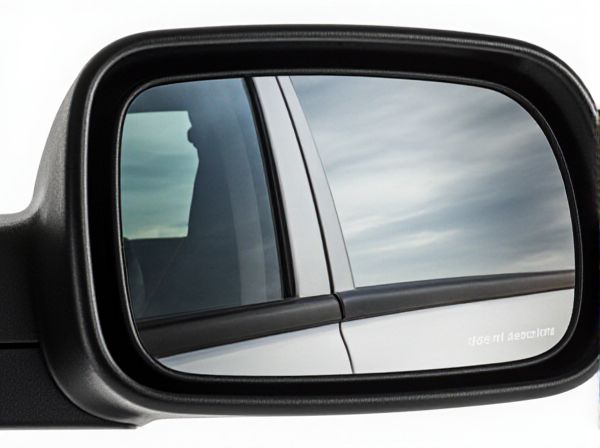
Photo illustration: Spotter Mirror vs Standard
A spotter mirror offers a wider field of view and enhanced visibility compared to a standard mirror, making it ideal for detecting blind spots while driving or cycling. Your safety increases as spotter mirrors reduce the risk of accidents by providing a clearer view of surrounding areas that standard mirrors might miss. Choosing the right mirror depends on your specific needs, whether it's for better maneuvering in tight spaces or improved awareness on the road.
Table of Comparison
| Feature | Spotter Mirror | Standard Mirror |
|---|---|---|
| Blind Spot Coverage | Expanded, reduces blind spots | Limited, standard field of view |
| Size | Smaller, convex design | Larger, flat or slightly curved |
| Installation | Clip-on or adhesive | Integrated with vehicle |
| Visibility | Wide-angle, enhanced situational awareness | Normal angle, standard awareness |
| Cost | Low to moderate | Standard vehicle cost |
| Safety Impact | Improves lane change safety | Basic safety support |
Introduction to Spotter Mirrors and Standard Mirrors
Spotter mirrors enhance vehicle safety by providing a wider field of view compared to standard mirrors, minimizing blind spots for drivers. These convex mirrors are specifically designed to improve visibility around the vehicle's perimeter, which standard flat mirrors often fail to cover sufficiently. Incorporating spotter mirrors into driving routines significantly aids in better situational awareness and accident prevention.
Key Differences Between Spotter Mirrors and Standard Mirrors
Spotter mirrors feature convex lenses that provide a wider field of view compared to standard flat mirrors, reducing blind spots and enhancing safety during lane changes. Standard mirrors typically offer a narrower, more focused reflection with minimal distortion, making them less effective for viewing adjacent lanes or blind spots. The design and curvature of spotter mirrors optimize visibility for drivers of larger vehicles such as trucks and buses, while standard mirrors are common in passenger cars.
How Spotter Mirrors Enhance Driver Visibility
Spotter mirrors significantly enhance driver visibility by expanding the field of view beyond the limitations of standard mirrors, reducing blind spots to improve safety. These convex mirrors allow drivers to detect adjacent vehicles, pedestrians, and obstacles that standard flat mirrors often miss. This advanced visibility is particularly crucial for large trucks and buses, where blind spots pose a higher risk during lane changes and turns.
Limitations of Standard Mirrors in Blind Spot Detection
Standard mirrors often have limited fields of view, creating blind spots that reduce driver awareness and increase the risk of collisions. Spotter mirrors feature convex designs that expand visibility around the vehicle, enhancing blind spot detection and safety. This improvement significantly reduces accidents caused by unseen vehicles or obstacles in adjacent lanes.
Installation Process for Spotter Mirrors vs Standard Mirrors
Spotter mirrors feature a straightforward installation process involving adhesive backing or clip-on mechanisms designed for quick mounting on side mirrors, requiring minimal tools and no professional assistance. Standard mirrors generally demand more extensive installation, often necessitating screw fittings or electrical connections for power features, making the process time-consuming and sometimes requiring expert help. The ease of installing spotter mirrors enhances user convenience and reduces setup time compared to the more complex procedures associated with standard mirrors.
Safety Benefits of Using Spotter Mirrors
Spotter mirrors significantly enhance vehicle safety by providing a wider field of view compared to standard mirrors, reducing blind spots and improving visibility of adjacent lanes. These mirrors help drivers detect pedestrians, cyclists, and smaller vehicles that standard mirrors often miss, lowering the risk of collisions during lane changes and turns. Integrating spotter mirrors into vehicle systems promotes safer driving environments, especially in urban and congested traffic conditions.
Cost Comparison: Spotter Mirrors vs Standard Mirrors
Spotter mirrors typically cost between $15 and $40, offering enhanced visibility and safety for drivers by reducing blind spots, whereas standard mirrors range from $10 to $20 but provide limited coverage. The higher initial investment in spotter mirrors can lead to fewer accidents and reduced repair costs over time, making them cost-effective in terms of long-term vehicle maintenance. Choosing spotter mirrors can improve driving safety despite their slightly increased price compared to standard mirrors.
Maintenance and Durability Considerations
Spotter mirrors typically feature shatterproof materials and weather-resistant coatings that enhance their durability compared to standard mirrors, which may be more prone to cracking and corrosion over time. Maintenance for spotter mirrors often involves less frequent replacement and easier cleaning due to anti-fog and scratch-resistant surfaces. Standard mirrors require more diligent upkeep to prevent damage from environmental exposure and may need more regular adjustments or replacements in harsh conditions.
Best Use Cases for Spotter and Standard Mirrors
Spotter mirrors excel in enhancing driver visibility for large vehicles like trucks and SUVs, making them ideal for monitoring blind spots during lane changes and parking maneuvers. Standard mirrors are best suited for everyday passenger cars, offering a clear rearview and sideview for routine driving in typical urban and highway settings. Use spotter mirrors primarily to reduce blind spots on vehicles with larger blind zones, while standard mirrors provide adequate visibility for standard-sized vehicles in normal traffic conditions.
Final Verdict: Choosing the Right Mirror for Your Vehicle
Spotter mirrors provide enhanced visibility by covering blind spots, significantly improving safety during lane changes and parking. Standard mirrors offer basic rearview functionality but lack the extended field of vision that spotter mirrors deliver. For drivers prioritizing advanced safety features and comprehensive situational awareness, spotter mirrors are the superior choice, while standard mirrors may suffice for everyday use in less demanding environments.
 caratoz.com
caratoz.com